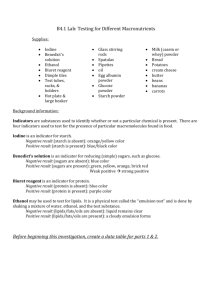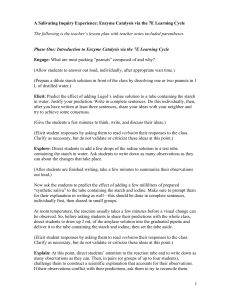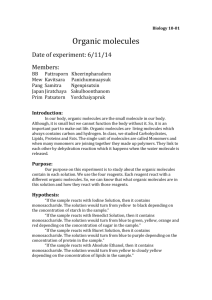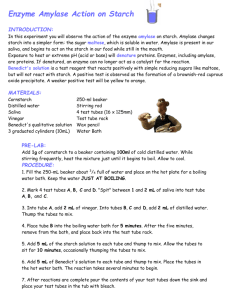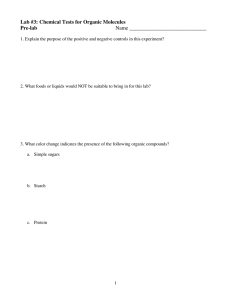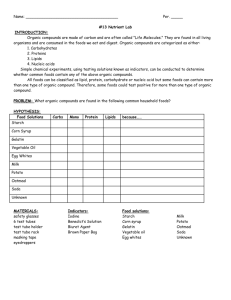Types of Carbohydrates Test
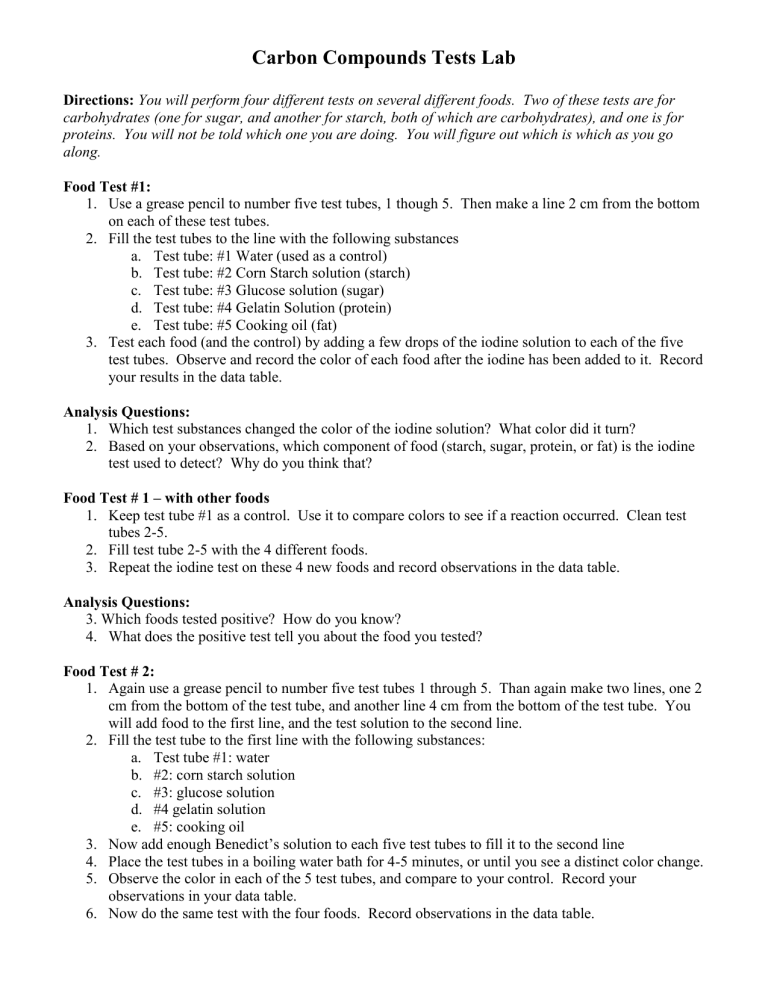
Carbon Compounds Tests Lab
Directions: You will perform four different tests on several different foods. Two of these tests are for carbohydrates (one for sugar, and another for starch, both of which are carbohydrates), and one is for proteins. You will not be told which one you are doing. You will figure out which is which as you go along.
Food Test #1:
1.
Use a grease pencil to number five test tubes, 1 though 5. Then make a line 2 cm from the bottom on each of these test tubes.
2.
Fill the test tubes to the line with the following substances a.
Test tube: #1 Water (used as a control) b.
Test tube: #2 Corn Starch solution (starch) c.
Test tube: #3 Glucose solution (sugar) d.
Test tube: #4 Gelatin Solution (protein) e.
Test tube: #5 Cooking oil (fat)
3.
Test each food (and the control) by adding a few drops of the iodine solution to each of the five test tubes. Observe and record the color of each food after the iodine has been added to it. Record your results in the data table.
Analysis Questions:
1.
Which test substances changed the color of the iodine solution? What color did it turn?
2.
Based on your observations, which component of food (starch, sugar, protein, or fat) is the iodine test used to detect? Why do you think that?
Food Test # 1 – with other foods
1.
Keep test tube #1 as a control. Use it to compare colors to see if a reaction occurred. Clean test tubes 2-5.
2.
Fill test tube 2-5 with the 4 different foods.
3.
Repeat the iodine test on these 4 new foods and record observations in the data table.
Analysis Questions:
3. Which foods tested positive? How do you know?
4.
What does the positive test tell you about the food you tested?
Food Test # 2:
1.
Again use a grease pencil to number five test tubes 1 through 5. Than again make two lines, one 2 cm from the bottom of the test tube, and another line 4 cm from the bottom of the test tube. You will add food to the first line, and the test solution to the second line.
2.
Fill the test tube to the first line with the following substances: a.
Test tube #1: water b.
#2: corn starch solution c.
#3: glucose solution d.
#4 gelatin solution e.
#5: cooking oil
3.
Now add enough Benedict’s solution to each five test tubes to fill it to the second line
4.
Place the test tubes in a boiling water bath for 4-5 minutes, or until you see a distinct color change.
5.
Observe the color in each of the 5 test tubes, and compare to your control. Record your observations in your data table.
6.
Now do the same test with the four foods. Record observations in the data table.
Analysis Questions:
5.
Which test substances changed the color of the benedict’s solution and what color did it turn?
6.
Based on these observations, what component of food does the Benedict solution test for?
Food Test #3
1.
Set-up test tubes 1-5 again. a.
Test tube #1: water b.
#2: corn starch solution c.
#3: glucose solution d.
#4 gelatin solution e.
#5: cooking oil
2.
Add 10 drops of Biuret solution to each test tube
3.
Record your observation in the data table
4.
Try the experiment again with the 4 foods and record your observations in your data table
Analysis Questions:
7.
Which test substances changed the color of the biuret’s solution and what color did it turn?
8.
Based on these observations, what component of food does the Benedict solution test for?
Food Test #4
1. Prepare five pieces of brown paper about 2inches by 2inches.
2. Label each piece of paper with the name of the food substance to be tested a.
#1 – water b.
#2 – corn starch solution c.
#3 – glucose solution d.
#4 - Gelatin solution e.
#5 – cooking oil
3.
Use a pipette to transfer a few drops of each test solution to your piece of brown paper
4.
Allow the test spots on each sheet of brown paper to dry.
5.
When dry bush and dried particles off the paper and hold the paper up to the light. Compare each of the papers with the control. The property of light passing through the paper is called translucence. Note whether light passes through the paper. Record your observations in your data table. Save the papers for comparison in the next part.
6.
Obtain 4 more sheets of brown paper, and label them with your four food items
7.
Now use your finger to rub each of these foods on a spot on the brown paper. Be sure to use a different finger of wash your finger before handling each food. You must rub very hard as you are trying to press food into the paper.
8.
Allow the paper to dry for a few minutes.
9.
When dry brush off and dried particles, and hold the paper up to the light and notes whether the spot is translucent. Record your results in your data table.
Analysis Questions
9.
Which of the four components can you detect using the brown paper test? Explain your reasoning.
10.
Which foods that you tested could be a good source of: protein? Starch? Fat? Sugar?
11.
Which foods contained more than one component?
Name(s):____________________________________________Period:__________Date:_____________
Food Test Data Table
Substance Tested Iodine Test
Observation
Benedict’s Test
Observation
Biuret’s Test
Observation
Brown Paper
Bag
Observation
Water
Corn Starch Solution
Glucose Solution
Gelatin Solution
Cooking Oil
Banana
Chopped, cooked egg white
Oatmeal
Marshmallow
Answer Analysis Questions 1-11 below.


